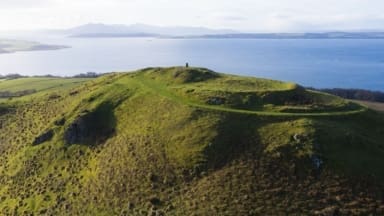
Advocating keeping the land, trees and credits together in one package, Jon Lambert, partner of Goldcrest Land & Forestry Group said he had become increasingly concerned about the concept of separating carbon credits from land and the trees growing on it. Lambert is calling on corporations, investors and individuals to buy and take responsibility for the land asset itself.
He said: “While carbon credit trading is a useful offsetting tool, the long term ramifications of separating the credits have not been thought through. It might seem simple – and well-intentioned – but things are rarely as straightforward as they look.”
His warning came with launch of the sale of a 144-ha broadleaved woodland in Ayrshire with 55,338 Pending Issuance Units (carbon credits given in advance of future carbon sequestration) included in the sale – for offers over £2million.
Mr Lambert said: “It is very unusual for a property to be sold with its PIUs but I believe it would be much better practice to keep woodlands and the carbon credits they generate together and this is an excellent example. I hope we will start to see many more properties like this on the market. The carbon credit system has its place but it is artificial and intangible. The focus is on the advantages of the immediate deal – money for the landowner, offsetting emissions for the purchaser – but it’s all very theoretical. I just want people to think about what they are actually being given.”
He said: “Corporations are spending millions buying certificates ‘off the shelf’ and take the credit for doing the right thing. However, they leave the responsibility with someone else and can kick up a stink when it goes wrong. The owner – and subsequent owners – is left with a management liability that in some cases stays with the land for a century. The land will be greatly reduced in value and become difficult to sell if that decision is ever made. Think about the woodland owner facing a near total tree wipeout from a Storm Arwen-type event and then facing a hefty corporate compliance department questioning their carbon sequestration. What happens then?”
“Surely buying the whole package makes more sense. The acquisition of Brisbane Mains, an interesting, beautiful and diverse area of land in West Scotland comes with 55,000 high quality carbon credits. This is a very attractive and tangible option. Here are the trees, here are the carbon credits, it all fits. Buy the land, put management in place, look after the trees, make an actual difference. Put that on the balance sheet.”
Managed by the Future Forest Company, which could be retained for ongoing management of Brisbane Mains, more than 200,000 trees have been planted for carbon sequestration, the majority of them native birches, oaks, native shrubs and Scots pine. It was planted in 2021 with the aid of a Forestry Grant Scheme which remains active until 2026 and will transfer to the purchaser.
CEO David Elliott said: “Brisbane Mains includes young and mature woodland, grasslands and peatland and is rich in biodiversity. The already abundant natural capital there will be amplified as it grows. It also offers considerable amenity value and is often visited by walkers and cyclists. The forest will continue to benefit people and we hope this sale will ensure its longevity.”
There is also ancient woodland, some of which was established more than 130 years ago, supporting species such as giant horsetail and hazel and alder woodlands. The land includes the medieval Knock Hill Fort, a fascinating historical landmark which overlooks the Clyde estuary.
Mr Elliott agreed that while the carbon credit marketplace was an important part of the green economy, the best possible ownership model lay in keeping the trees and credits together, thus incentivising the ongoing enhancement of the woodland. Adding that any profit would be invested into new afforestation projects, he said: “This is a very positive proposition, offering purchasers something new to buy into and it will be interesting to test the market reaction.”

